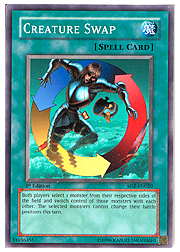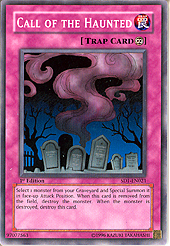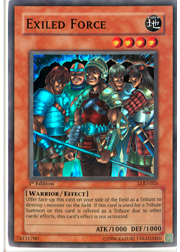Shonen Jump Championships test the mental aptitude and skill of any duelist. When facing serious games against serious duelists, it pays to remember the basics and the tricks of your deck. In the midst of a heated duel, it can be easy for any player to forget a ruling or an advanced mechanic that could have made the difference between victory and defeat.
It is my goal, dear student, to provide a refresher course of rules that should be remembered at such a large event. We’ll look at common mistakes that duelists make when facing cards that they may have seen countless times in the past, and also look at rules of the game that can help us see new opportunities that we might have overlooked.
Creature Swap
I’m sure that some of us have run into a situation like this. During Evan’s previous turn, he attacked his opponent’s Sangan and destroyed it. Rachel, his opponent, used Sangan’s effect to search his deck and choose Magician of Faith. When Rachel entered her first main phase, she set a monster and ended her turn. Evan has a suspicion that the set card is the very same Magician of Faith that was searched out with Sangan’s effect.
 Evan draws for the start of his turn and receives Creature Swap. He sets a plan in motion to take Magician of Faith by activating Creature Swap. When it resolves, he decides to give Rachel Winged Kuriboh and she gives him the face-down monster. Sure enough, the monster is Magician of Faith. Feeling the rush, Evan proceeds to flip-summon Magician of Faith . . .
Evan draws for the start of his turn and receives Creature Swap. He sets a plan in motion to take Magician of Faith by activating Creature Swap. When it resolves, he decides to give Rachel Winged Kuriboh and she gives him the face-down monster. Sure enough, the monster is Magician of Faith. Feeling the rush, Evan proceeds to flip-summon Magician of Faith . . .
. . . and now, we have to pause the tape. What did Evan do wrong, class? He got the monster he wanted, right? His monster hasn’t violated any of the rules of battle position changes. Things look good so far.
He certainly passed on most counts, but he forgot that one little nagging rule of Creature Swap—“The selected monsters cannot switch their battle positions this turn.” This means that Magician of Faith is stuck in defense position. Unless Evan has a card effect that he can use to change Magician of Faith’s battle position, that little Magician isn’t going to give him a spell card that turn.
Does Evan’s mistake sound familiar? I think we can all admit that we’ve made the same mistake at least once in our dueling history. The important thing is that we learn from it.
Torrential Trouble
 The first thing every player needs to remember about Torrential Tribute is that you can’t activate it when your opponent sets a monster. Torrential Tribute has three events that it looks for: a normal summon, a flip summon, and a special summon. Setting a monster is not included in those events. But what happens when a monster is special summoned face down? Can you use it then? The answer is yes.
The first thing every player needs to remember about Torrential Tribute is that you can’t activate it when your opponent sets a monster. Torrential Tribute has three events that it looks for: a normal summon, a flip summon, and a special summon. Setting a monster is not included in those events. But what happens when a monster is special summoned face down? Can you use it then? The answer is yes.
Let’s say that your opponent were to flip summon Cyber Jar during his main phase. After its effect resolves, you would be able to use Torrential Tribute to destroy every monster on the field—even if your opponent chooses to special summon all of his monsters face-down! But you must remember that Torrential Tribute cannot be activated during the damage step. If Cyber Jar is flipped by an attack, you won’t have an opportunity to use Torrential Tribute.
The Meaningless Haunted
 Have you ever watched a player use Call of the Haunted to special summon a monster and then tribute that summoned monster for another high-level monster, like Airknight Parshath? What do they do with Call of the Haunted? Do they put it into the graveyard?
Have you ever watched a player use Call of the Haunted to special summon a monster and then tribute that summoned monster for another high-level monster, like Airknight Parshath? What do they do with Call of the Haunted? Do they put it into the graveyard?
Well, they shouldn’t. You see, when you tribute a monster that’s special summoned by Call of the Haunted, Call of the Haunted will remain on the field with no further effect. This means that Call of the Haunted remains face-up in the spell and trap zone and no longer serves any purpose. It’s just a meaningless trap card that gets in the way. Destroying Call of the Haunted won’t remove any monsters from the field, so don’t waste any cards on removing it unless you really need to get it out of the way for some reason.
Nobleman of Crossout
Ever watch another player take their monster destroyed by Nobleman of Crossout and place it in their graveyard? They probably need a friendly reminder that monsters destroyed by Nobleman of Crossout are removed from play. Yes, that’s written in the text of Nobleman of Crossout, but we’ve all made this mistake before.
This brings me to another one of the big Nobleman of Crossout errors. The Lost Millennium gave us D.D. Survivor, which is another fun “D.D.” monster. D.D. Survivor is D.D. Assailant’s worst enemy, with an effect that can return it to the field after being removed from play. But this effect depends on one specific criterion—D.D. Survivor must be removed from play while it was face up on the field. If it was removed from play while it was face down for any reason, it will not return.
If D.D. Survivor is face-down on the field and a player uses Nobleman of Crossout on it, what happens? As D.D. Survivor was face-down when it was destroyed and removed from play, it will not be special summoned during the end phase . . .but I bet you’ve seen some players special summon it anyway, haven’t you?
Exiled Force
 “I use Exiled Force to destroy your Black Luster Soldier – Envoy of the Beginning.”
“I use Exiled Force to destroy your Black Luster Soldier – Envoy of the Beginning.”
“Okay, then I Ring your Exiled Force.”
Does anyone see a problem here? It might not be apparent from the dialogue between the players, but a quick look at the text of Exiled Force should make it clear. You see, when you activate the effect of Exiled Force, you have to tribute it. This is a cost that must be paid when the effect is activated. And where does Exiled Force go when you tribute it? Why, it goes to the graveyard!
Where does this leave the other player’s Ring of Destruction? He can still use it, if he wants, but it won’t be able to touch Exiled Force. Exiled Force is already pushing up the daisies in the graveyard. It’s far too late to use Ring of Destruction on it.
Thousand-Eyes Restrict
Let this serve as a reminder that Thousand-Eyes Restrict doesn’t have the same feedback damage effect as Relinquished. When Thousand-Eyes Restrict battles with a stronger monster and Thousand-Eyes Restrict would be destroyed, the monster that Thousand-Eyes Restrict “absorbed” is destroyed instead, but the controller of Thousand-Eyes Restrict is the only player that receives the life point damage. The damage is not also dealt to the opponent—that’s the job of Relinquished.
Single-Serving Kuriboh
 “I summon Armed Samurai – Ben Kei and equip it with Axe of Despair, Mage Power, and Fusion Sword Murasame Blade. Now I attack with it.”
“I summon Armed Samurai – Ben Kei and equip it with Axe of Despair, Mage Power, and Fusion Sword Murasame Blade. Now I attack with it.”
“Okay, I discard Kuriboh.”
“Okay. Then I attack again.”
“But I used Kuriboh, so I don’t take damage.”
I’m sure that many Armed Samurai – Ben Kei players have run into this one. You see, what the opponent said about Kuriboh isn’t accurate. Kuriboh is only good for one attack. It will prevent the battle damage to your life points from one attack, and only from one attack. While Kuriboh can protect your life points from one of Armed Samurai – Ben Kei’s attacks, it will do nothing to save you from its remaining attacks.
In the situation above, the player with Ben Kei will be able to attack three more times and the life point damage from those attacks will not be reduced by Kuriboh. That means three more attacks from a monster with 3800 ATK.